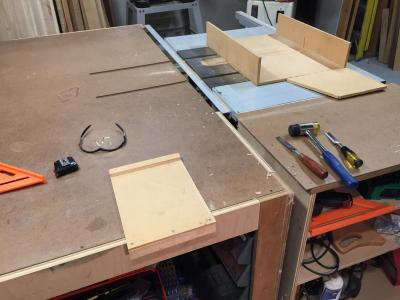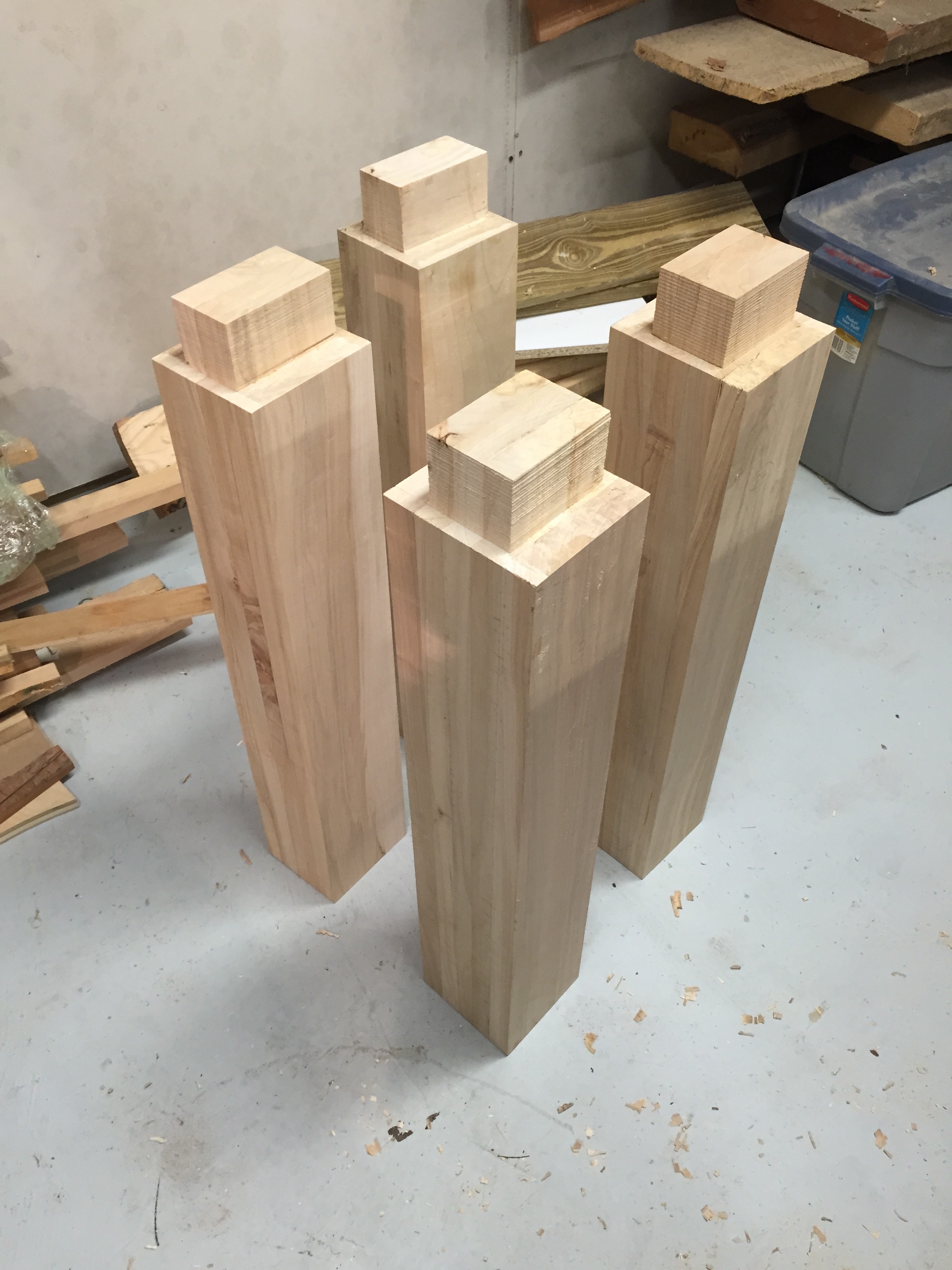Trued Up the Legs and Thoughts on the Hardness of Silver Maple
Primary tabs
 The last time I tried to rush on this project, I just about screwed up the legs while trying to cut their tenons on the table saw. Over the last couple of days, I got back into the shop and basically treated these like I would a handcut dovetail layout and preparation. Since I don't have a good workholding surface at this point, I've gone back to simple tools and simple solutions. First, I took the two front and two rear legs through the surface planer so that each pair has the same width and depth. The lengths were already accurate. Once that was done, I used hand tools to fix the tenons. Since I glued the legs up from planks of varying thicknesses, I ended up with tenons that are not exactly the same distance from the front and back of the legs. Instead I focused on the side to side location of the tenons, and making sure that the shoulder is accurately at the same depth all the way around on all four legs.
The last time I tried to rush on this project, I just about screwed up the legs while trying to cut their tenons on the table saw. Over the last couple of days, I got back into the shop and basically treated these like I would a handcut dovetail layout and preparation. Since I don't have a good workholding surface at this point, I've gone back to simple tools and simple solutions. First, I took the two front and two rear legs through the surface planer so that each pair has the same width and depth. The lengths were already accurate. Once that was done, I used hand tools to fix the tenons. Since I glued the legs up from planks of varying thicknesses, I ended up with tenons that are not exactly the same distance from the front and back of the legs. Instead I focused on the side to side location of the tenons, and making sure that the shoulder is accurately at the same depth all the way around on all four legs.
I got them to a point where they won't embarrass me when assembled. The tenons, though differing sizes, are all square and beefy enough to hold offset pegs. And in any case, the exact locations of the mortises for these tenons will simply be traced from the tenons themselves after I assemble the whole undercarriage into one assembly. I'm still working on dimensioning the boards for the stretchers. Since I have no boards thick enough to function simply as stretchers on their own, each of the four will once again be a glue up of a wide board and a thinner board. I probably need to sharpen up my planer blades. This maple is HARD.
Speaking of which, I'm a bit confused by my experience compared to what I've been told when it comes to the hardness of various species of wood. At this point, I've done some significant work in a variety of types of wood, and what I'm finding doesn't match the reports. Point of fact, for this bench, in what I know is silver maple from a tree I saw daily as a child, this silver maple is not acting like 'soft maple'. It's acting more like hard maple. I've cut some hard maple, and this stuff is barely easier to work than that was.
 I've seen silver maple listed variously as 'fragile' and 'brittle'. Perhaps this tree was a hybrid, like a Freeman Maple, made from crossed silver maple and red maple? I don't know for certain, but when I look at a table of Janka numbers for various woods, I do ahve a bit of a sense about these things now. According to the numbers, the hardest thing I've ever had direct experience with is Rosewood at 1780 on the Janka scale. Now rosewood was hard, but I have to say that the actual hardest thing I've ever cut was a piece of black locust I inherited from my Dad's farm. The Janka number for locust wood is 1700, but if I had to guess, the piece I cut was at least over 2000. On the soft end, I've been kind of startled at how soft cherry is, at 950. Now I've of course cut poplar at 540 and basswood at 410, and they're both softer than cherry, but not by much. Most of the pieces of cherry I've worked have seemed closer to a 600.
I've seen silver maple listed variously as 'fragile' and 'brittle'. Perhaps this tree was a hybrid, like a Freeman Maple, made from crossed silver maple and red maple? I don't know for certain, but when I look at a table of Janka numbers for various woods, I do ahve a bit of a sense about these things now. According to the numbers, the hardest thing I've ever had direct experience with is Rosewood at 1780 on the Janka scale. Now rosewood was hard, but I have to say that the actual hardest thing I've ever cut was a piece of black locust I inherited from my Dad's farm. The Janka number for locust wood is 1700, but if I had to guess, the piece I cut was at least over 2000. On the soft end, I've been kind of startled at how soft cherry is, at 950. Now I've of course cut poplar at 540 and basswood at 410, and they're both softer than cherry, but not by much. Most of the pieces of cherry I've worked have seemed closer to a 600.
Now, I'm sure that there is variation in every species and definitely within every tree. So I guess I've learned to take the hardness descriptions with a huge pinch of salt. In fact, I'd say the accepted numbers of most species are probably plus or minus 50% in hardness, meaning that any given piece of silver maple may sit at the soft maple number of 950 (i.e. the same as cherry) but depending on the tree and the board, it may be as high as 1400 and as low as 450. Yeah, but even with that range, I have to say that the various pieces of soft maple I've worked, even those purchased at lumber stores, I've never encountered a piece that was as soft as the average piece of cherry I've worked.
OK, so given black locust at 2000 and poplar at 540, I'd judge this silver maple I'm working on this bench is probably closer to 1300. (I suppose if I want to be pedantic I should just get a 40mm steel ball and a hydraulic press and do the experiment myself.) My point, though is just that, I routinely make life hard for myself. Making a bench out of this stuff is turning out to be a great deal of work and is taking a toll on my tools. Still, I should end up with a tank of workbench at the end.

